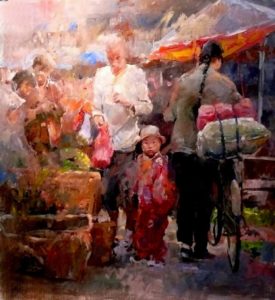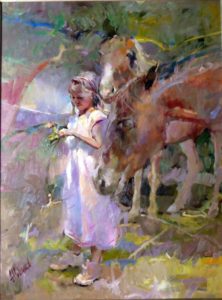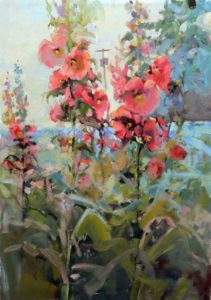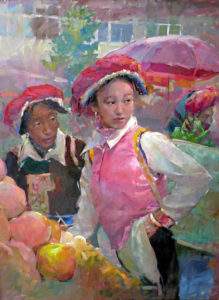by guest artist/author: Gary Holland
Don’t we all wish we’d had good art instruction when learning to paint!
I did not have that luxury 30 years ago, not having a lot of money to attend a good school, if one existed. Indeed, so few strong art schools existed in the world ruled by abstract expressionism where your art had to be “new under the sun” or it was not valid.
Discouraged and then disgusted, I quit trying. Instead I studied music and learned my art from books (the 25 year learning curve).
I am passionate about providing good training for artists, precisely because I didn’t have good training. I know the chronic pain of struggling, doubting, dreaming of being an artist. Perhaps that strikes a chord with you?
“I’ve never met an artist whose spirit didn’t want to fly.” ~Gary Holland
Here are some things I feel make for a good art teacher. The optimal art instructor should:
- Be a working professional (not amateur) artist, not just a teacher.
- If your work is abstract in orientation, be able to show you can paint fruit, trees, portraits.
- If Degas and Picasso could paint nice portraits in their early years, shouldn’t we? Guess what: Your students most likely want to paint representationally, at least for now.
- Use demonstration to communicate more often than you use words.
- Artists are visual learners.
- Teach fundamentals, simply, sequentially, being able to clearly explain your method.
- I personally believe that without solid technical ability (being able to quickly and accurately paint whatever I see,) my ability to create real art (technique + spirit = real art) will not happen.
- Again, technique does not = art. It’s technique, coupled with a passionate art spirit that produces the visual expression of your soul. That’s art.
- Without the spirit coming through your art, you are just decorating walls. (High-priced wallpaper.)
- And conversely, creativity without solid technical skill to express it. Your lack of skill will get in the way and the spirit of your work will essentially be stillborn.
- If I cannot condense my (technical) instruction into simple 1,2,3-style lessons, with quick, clear demonstrations, then is it possible I don’t really know what I’m doing?
- Learning to focus one’s instructional technique can serve to elevate the quality of your art.
- I believe that technique can be taught, however turning technique into art (the infusion and expression of your spirit and technique) is best facilitated, not directed.
- A student needs to find their own path to creativity, which is largely intuitive.
- My goal after teaching solid technique is to offer students direction, then await the evolution of the artist-in-the-making.
- After learning some foundational technique, I try to facilitate the growth of their artistic spirit by exposing them to favorite books, prints, galleries , psychological ideas, emotions, symbols, other forms of artistic passion, etc.
- From this, they slowly create their own path, upon which their spirit can walk without my help.
- If I don’t do these things, I should recognize that my goal is not the growth of the competently creative student; rather I should admit that I just want to make money off of them, or worse, to turn them into clones of myself.
- (An artist’s dream is infinitely more important than a teacher’s ego. Haven’t we all seen the Leffel clones, Berberian clones, Warhol clones, and been instantly turned off to their art?
- (Seeing an artist work so hard to paint like someone else makes me shudder. What a waste of a soul!)
Like a butterfly with a broken wing, an art student should be inspired, nurtured and trained, then encouraged to fly away to be the best and most beautiful butterfly in the sky. The teacher moves from “teacher” to “cheerleader” once students begin to fly.
You can see what I do at http://thecreativetraveler.org/or http://hollandgallery.com/
If you want to study w/me, feel free to call for information: (208) 860-0603
*****
Gary Holland began his studies alone, learning by copying the famous artist’s paintings. Later he would study with such instructors as Daniel Green, Ramon Kelley and Zhang Wen Xin. His recent work includes paintings that reflect the life and culture of the world’s poorest children. Combining art with compassion, Gary Holland founded the For the Children, Inc. charity. Sales of Holland’s art and books help support underfunded orphanages in Haiti, Vietnam and China.
We are all lucky to have Gary share his talent and suggestions with us. I met Gary on Twitter and was very impressed with his paintings. He is an artist with true spirit and I think his paintings are magical like butterflies!
Lori 🙂
 (Young boy at Market by Gary Holland)
(Young boy at Market by Gary Holland)
 (My Secret Place by Gary Holland)
(My Secret Place by Gary Holland)
 (Hollyhocks by Gary Holland)
(Hollyhocks by Gary Holland)









Thank you Lori. I just finished my first full year of leading workshops and I still have so much learn. Your article gave me a lot of inspiration and very useful information.
Thanks Dianne for the nice comment. Good luck on your artistic journey. Thank goodness, it never ends! 🙂 Lori
This article seems to be named wrong. This looks like an article with tips on how to BE a great instructor, not how to FIND great art instruction.
Well, thanks for pointing that out! Hope you still found it helpful…